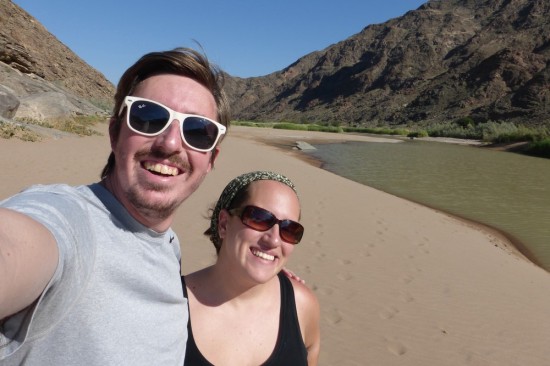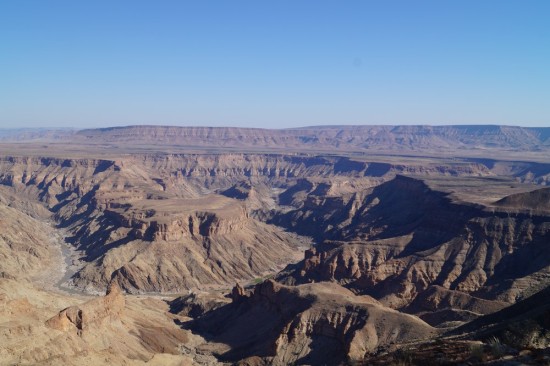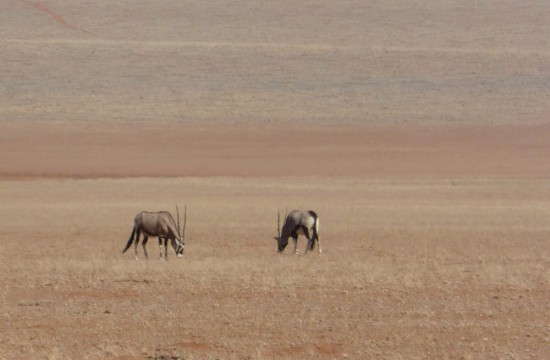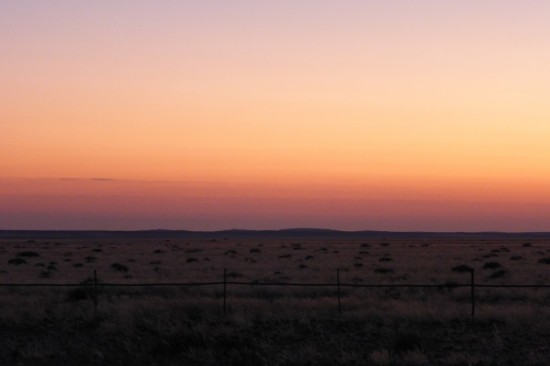
Southern Africa Road Trip: Our Luck Changes
(This is the third post in our Southern Africa Road Trip Series. Feel free to start at the beginning: Let’s Road Trip Through Southern Africa!)
After our rocky start to the road trip, our luck began to change on day three and we never looked back. We awoke at our campsite in beautiful Ai-Ais, at the southern end of Fish River Canyon in southern Namibia. We spent the next day there just relaxing, reading, hiking, and talking to some other campers. The campsite we were staying at was also a luxury lodge, so even though the camping was relatively inexpensive, it had several great amenities:
- Several large, nice outdoor kitchens with gas stoves and deep sinks
- Potable water at the campsite and in the kitchen
- Restaurant and bar
- Small grocery store that, much to my delight, sold reasonably-priced red wine
That’s the kind of camping Adam likes to do. We struck up a friendly conversation with our neighbors (Peter and Dorothy from the UK – the downside to waiting a month to write blog posts is that you forget details like this. I know her name was Dorothy and I’m pretty sure on the rest, but not 100%) and got along well with them, though they left the next day.
Because of its location at the southern end of Fish River Canyon, Ai-Ais is also the end point for people doing the 85k (~53 miles) 4-day hike of the entire canyon. It was pretty cool to see the hikers finish and celebrate with each other – they all sprint in from the end of the canyon to the campsite and everyone around (including the staff at the campsite) cheers and they run toward a large brass bell that they ring to signify the end of their journey. The people we met who had completed the hike were all fun to talk to and provided a lot of advice about our onward travel through Namibia and Zimbabwe, which was a nice bonus.
After spending the day relaxing and planning the rest of our road trip, we bid farewell to Ai-Ais and headed north toward Keetmanshoop (over 100k out of our way) so we could get a replacement for our shredded right rear tire. Had the spare been the right size we may have just driven on since we had a second spare, but we didn’t feel comfortable driving on the bumpy sand and gravel Namibian roads with differently-sized tires since we would be liable for damage to the suspension system of the car.
On the way to Keetmanshoop, we stopped at the northern end of Fish River Canyon to visit the main viewpoint. The canyon is generally regarded as the second largest in the world behind Arizona’s Grand Canyon so we were excited to get a look at it from above. We rolled up to the viewpoint and were happy to see that there was only one other car there with only three people in it. We lingered for about 45 minutes and those are the only three people we saw, so while the Grand Canyon may be bigger and I’m sure it’s beautiful (neither of us have been), I think Fish River Canyon may have the edge as an attraction simply because you’re all alone and can really appreciate the isolation and enormity of the place without thousands of other people around. We’re really glad we got a chance to visit. After a picnic lunch at the canyon, we continued on to Keetmanshoop to get our new tire.
It’s probably because so many of the roads are made of rocks and gravel, but tire places are a dime a dozen in Namibian towns (unfortunately, the towns are 200k apart). Upon entering Keetmanshoop we found four places right off the bat and picked one based on the facts that they sold the brand we needed and looked like they weren’t busy. I am not exaggerating when I say they changed this tire with NASCAR-like speed. After agreeing on a price and handing over my keys, I went into the small office to pay (by Credit Card because Namibia is awesome and everyone takes Visa – I’m looking at you, South Africa) which took about five minutes. In all seriousness, when I walked out, the work was done and a shiny new tire was on the car with our wrongly-sized spare already back in its place on the roof of the cab. I have no idea how one guy did that so fast, but we were very grateful.
We had picked out three different campsites we would try to reach by sunset, based on how long the tire changing took. When the whole affair took no more than ten minutes, we quickly decided to make it all the way to our actual destination, Sossusvlei. After two days of driving and a day of doing basically nothing at Ai-Ais, we were looking forward to actually, you know, “doing things” on this road trip which meant finally reaching our target campsite before sundown.
In our previous couple days of driving, we had only spent about an hour on dirt and gravel roads. The drive to Keetmanshoop was largely on gravel, but the roads were in good shape so we made good time. The roads between Keetmanshoop and our campsite, however, were mostly gravel and not in the best shape. Going was slow, and we learned early on that our carefully-calculated estimated drive time was based on Serena’s (our GPS) assumption that we’d go the speed limit – something I was not willing to do since the roads were made of rocks and the limit was 70 mph. As the sun got lower and lower, we began to realize that we would not make it to our campsite before dark after all and started looking for any campsite at all that we could stay at instead.
At this point, you may be thinking to yourself “Ok, Adam, seriously, just drive at night!” Well, that’s not a very good idea in Namibia. There are animals everywhere in this country, and not squirrels and deer, but elephants, giraffes, rhinos, and tens of thousands of gemsbok. What’s a gemsbok? This is a gemsbok:
It’s like a deer, except the average length of the horns is 33 inches and the normal weight of a male is about 600 pounds (compare to a white-tailed deer with antlers of about 12 inches in length and males around 280 lbs). These animals cross the road freely, there are absolutely no lights anywhere, and when you hit one (assuming you live), you’re stranded in one of the most remote parts of the world with no cell reception and may not see another person for 48 hours or more. That’s why we were so hung up on arriving at campsites by sundown.
And so we drove northward, simultaneously marveling at the unbelievably gorgeous sunset taking place to our left and cursing it as we looked for any signage indicating a campsite. Mercifully, just as the sun dipped below the horizon, we came upon a small family-run campsite with a few other patrons also sleeping in pop-up campers, and pulled in. After some quick questioning from the woman who runs the place (screening the customers to keep shady people out because the campsite adjoins their front yard where her kids play) we were admitted and got settled in for the night. Only a couple hundred kilometers from our intended destination, it would do for the night and tomorrow held the promise of finally getting this road trip on track.
The other campers we met were, just like everyone else we met in Namibia, incredibly nice and helpful. They were South Africans who now lived in Namibia and were on their way home after a couple weeks of camping in the north of the country. Upon learning that we were new at this whole thing, they immediately offered up all their leftover supplies including mosquito spray and citronella patches for the inside of our camper (which we needed as we were entering Malaria and Dengue Fever zones). The next morning, hearing that the door on our camper was squeaking loudly when opened/closed, one of them came over and applied grease to all the hinges, which allowed us to operate the door without waking up the entire campsite. Like I said, everyone we met in Namibia was awesome.
Continue along our adventure: Southern Africa Road Trip: Sossusvlei





[…] Read the next post in this series: Southern Africa Road Trip: Our Luck Changes […]